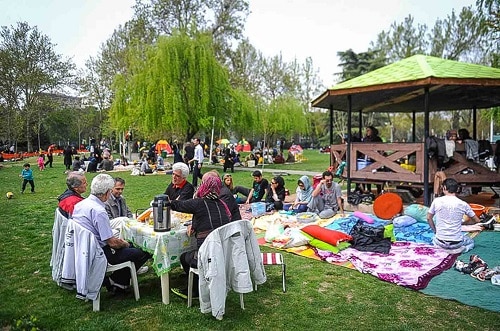The Sizdah be dar is the thirteenth day of Farvardin (1th day of Avril) and is one of the Nowruz celebrations. In the official calendars of Iran, this day is named Nature Day and is an official holiday. At the beginning of the new year, after twelve days of celebration and rejoicing, reminiscent of the twelve months of the year, the ancient Iranians used to go to the garden and the desert on the thirteenth day of Nowruz, which is a happy day, and wish rain from God, and in fact This was the end of the official Nowruz period. Today, families go to parks and green areas and nature. Playing games, having lunch or often making kebabs in nature, jokes and singing with family and friends have given a special joy to this day. If you are in Iran on the 13th of Farvardin, which coincides with the first day of April, you will surely be surprised by the large number of families who go to parks and picnics, or you will stay in traffic for a few hours.
Antiquity of Sizdah be dar
First of all, it should be noted that in Iranian culture, none of the days of the year are considered “bad” ” or “sinister”, but as we know, each of the days of the week and month has beautiful names and in connection with one of the manifestations of nature or God and Amshaspandan.
The thirteenth day of each solar month in the Iranian calendar is also called “Tir Rooz”, which is for star of Tishter, the rainy star, and Iranians have chosen this day Because of the embarrassment, for the first celebration of Tirgan of the year.
Also, in none of the ancient texts and no scientist or writer, this day (Sizdah be dar) has been mentioned badly, but in most of the writings and books, the thirteenth of Nowruz has been mentioned as a happy day. But after the influence of European culture during the Safavid rule, in this culture, the number 13 was considered unlucky, some people believed that April 1th is unlucky or to escape this misfortune you have to go to nature. But the only thing we can find in Iranian culture about the number thirteen is that the number 13 is “bad-tempered” because of its inseparable nature (this is a sign of Iranians’ high knowledge of mathematics and its use in everyday life.)
Sizdah be dar Rituals
The methods of holding the sizdah be dar, as well as the rituals and customs of the sizdah be dar, are very different and widespread in the tribes and regions.
The event has special rituals that have emerged throughout history and have gradually taken on the face of tradition, including the rituals of tying greens, planting greens, eating lettuce and Secanjebin, cooking a variety of dishes, especially noodle soup and to throw 13 Stone, and pottery divination.
Other rituals of Sizdeh Badr, such as Chaharshanbeh Soori and Nowruz, are numerous, beautiful and lovable, group games, songs and mass dances, field plants, public cooking, kite-flying, horseback riding, and show. Happy celebrations, youth gatherings, sprinkling and water games are some of these rituals that are rooted in mythological beliefs and culture.
This post is also available in:  中文 (Chinese)
中文 (Chinese)








